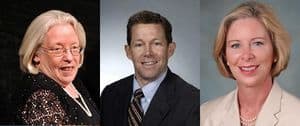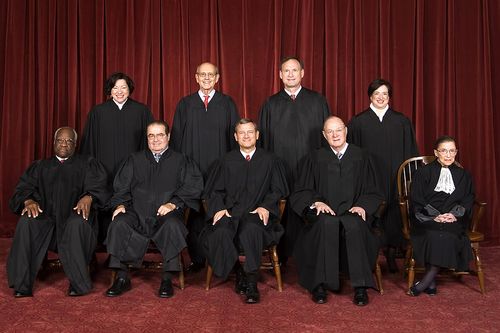As widely expected, the Supreme Court decided to hear four marriage equality cases out of the Sixth Circuit. Cases from Michigan, Ohio, Kentucky, and Tennessee will be consolidated into one omnibus marriage hearing over 2 1/2 hours. With the order issued today, the briefing schedule has the parties' briefs due between February and April. That means that the Court could issue a decision by the end of June 2015.
Unlike the last time the Court heard a case challenging a state ban on marriage equality (the Prop 8 case), the Court does not appear likely to sidestep the central issue. The "questions presented" for the hearing are as follows:
1. Does the Fourteenth Amendment require a state to license a marriage between two people of the same sex?
2. Does the Fourteenth Amendment require a state to recognize a marriage between two people of the same sex when their marriage was lawfully licensed and performed out-of-state?
These are the legal questions at the heart of the marriage equality movement. They should be squarely addressed in this case.
This post begins a series of analyses and reports on the case, which will be rolled out as the case unfolds over the next couple of months.
For now,the first of several initial considerations as we take the next step in this journey.
CONTINUED, AFTER THE JUMP…
This was expected.
 Although the Supreme Court does not have to hear cases when there are conflicting opinions from federal appellate courts, circuit splits, as they are called, are among the most common reasons why the justices agree to take a case. The Fourth, Seventh, Ninth, and Tenth Circuits all held that bans on gays marrying violate either the Equal Protection Clause or the Due Process Clause of the Constitution. However, the Sixth Circuit Court of Appeals, in a rambling, off-topic opinion, held that the Constitution does not prevent states from banning gays from marrying. In reality, the Sixth Circuit didn't even say that: Judge Sutton's opinion, as I argued here, essentially abdicated the judiciary's role as he threw up his hands in the face of a majority of state voters who had once supported a ban on the freedom to marry.
Although the Supreme Court does not have to hear cases when there are conflicting opinions from federal appellate courts, circuit splits, as they are called, are among the most common reasons why the justices agree to take a case. The Fourth, Seventh, Ninth, and Tenth Circuits all held that bans on gays marrying violate either the Equal Protection Clause or the Due Process Clause of the Constitution. However, the Sixth Circuit Court of Appeals, in a rambling, off-topic opinion, held that the Constitution does not prevent states from banning gays from marrying. In reality, the Sixth Circuit didn't even say that: Judge Sutton's opinion, as I argued here, essentially abdicated the judiciary's role as he threw up his hands in the face of a majority of state voters who had once supported a ban on the freedom to marry.
What's more, Justice Ginsburg had telegraphed this publicly. Justifying the Court's refusal to hear cases coming out of the Fourth, Seventh, and Tenth Circuits, the leader of the Court's progressive wing stated that the Court only gets involved when it has to. She suggested that we "pay attention to the Sixth Circuit," which ultimately gave her the invitation she wanted.
The Court has already tipped its hat which way it's leaning.
We cannot be sure how the justices will rule. No one can. But several pieces of evidence suggest that the Court is leaning in the direction of recognizing a nation wide freedom to marry. Let's review the evidence:
1. The Court let stand pro-equality decisions in the Fourth, Seventh, and Tenth Circuits, eventually bringing marriage equality to states like Kansas, South Carolina, Utah, Montana, and Idaho. Of course, allowing lower court decisions to stand without review does not necessarily mean a majority of the Supreme Court would have sided the same way, but it does mean that there were 6 justices who did not want to take the case (you need 4 to grant a petition). So, in addition to the liberal justices not wanting to rock the boat, two conservatives had to agree to see marriage equality come to a wide swath of the country. It seems manifestly unlikely that the Court would let thousands of gay couples marry and then, several months later, take it all back.
2. The Court rejected a petition to extend the stay holding back Florida's marriage equality order. As I argued here, this was an important step because it was the first time the Supreme Court had allowed marriage equality to go into effect in a jurisdiction beyond those covered by pro-marriage equality decisions from a federal appellate court. The Eleventh Circuit remains silent on the matter. To allow marriage freedom without a covering appellate court decision is even more a signal of where the Court is headed.
3. Justice Kennedy is the swing vote and although none of his LGBT rights opinions — including Romer, Lawrence, and Windsor — are explicitly pro-marriage equality, a reasonable interpretation of those opinions is that Kennedy has taken the slow, scenic route to marriage. First, he started with recognizing that gay persons are a protected class under the Constitution and, as such, they deserve certain rights against discrimination (Romer). Then he held that those rights extend to gay persons' intimate associations, or the rights to decide with whom to express love (Lawrence). Finally, he decided that the federal government had no legitimate reason to discriminate against legally married same-sex couples (Windsor). In deciding Windsor, not only did Justice Kennedy destroy all the arguments justifying the Defense of Marriage Act, but he also eviscerated the arguments propping up any remaining state bans on the freedom to marry. We know what comes next.
Stay tuned to Towleroad for additional analysis as the story unfolds.
***
Follow me on Twitter and on Facebook.
Ari Ezra Waldman is a professor of law and the Director of the Institute for Information Law and Policy at New York Law School and is concurrently getting his PhD at Columbia University in New York City. He is a 2002 graduate of Harvard College and a 2005 graduate of Harvard Law School. Ari writes weekly posts on law and various LGBT issues.




